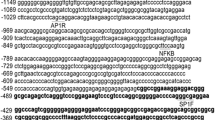Abstract
Homeobox (HOX) genes are crucial regulators of cell growth and differentiation. These genes initiate and control gene expression cascades that drive development. More recently, the absent or aberrant expression of HOX genes has been implicated in cancer development. Despite the observance of these expression changes, the regulation of the HOX genes in adult tissues and how these genes become deregulated in cancerous tissues still needs much investigation. We characterized the promoter region of the HOXB13 gene. A 3 kb region upstream of the HOXB13 gene, which included the 5′UTR, increased reporter gene expression in LNCaP cells by approximately 99 fold over the promoterless control construct. A highly conserved 179 base pair fragment containing only the 5′UTR of the HOXB13 gene constituted a minimal promoter in the LNCaP cell line. Strong promoter activity was seen in the presence or absence of testosterone, although testosterone exposure did decrease expression in LNCaP cells by 50%. In an androgen insensitive cell line Du145, no sensitivity to testosterone was detected and a consistent low basal level of expression was observed. Since HOXB13 expression is highly tissue specific, we investigated the ability of the promoter to drive expression in tissues other than prostate. We observed highest expression in LNCaP cells with low levels of expression in lung, retinoblastoma, and colon cancer cells and higher expression in MCF7 breast cancer cells.






Similar content being viewed by others
References
Hombria JC, Lovegrove B. Beyond homeosis–HOX function in morphogenesis and organogenesis. Differentiation 2003;8:461–76.
Kmita M, Duboule D. Organizing axes in time and space; 25 years of colinear tinkering. Science 2003;5631:331–3.
Lappin TR, Grier DG, Thompson A, Halliday HL. HOX genes: seductive science, mysterious mechanisms. Ulster Med J 2006;75:23–31.
Chen H, Sukumar S. HOX genes: emerging stars in cancer. Cancer Biol Ther 2003;2:524–5.
Nunes FD, de Almeida FC, Tucci R, de Sousa SC. Homeobox genes: a molecular link between development and cancer. Pesqui Odontol Bras 2003;17:94–8.
Cillo C, Cantile M, Faiella A, Boncinelli E. Homeobox genes in normal and malignant cells. J Cell Physiol 2001;188:161–9.
Cillo C, Faiella A, Cantile M, Boncinelli E. Homeobox genes and cancer. Exp Cell Res 1999;248:1–9.
Zeltser L, Desplan C, Heintz N. Hoxb-13: a new Hox gene in a distant region of the HOXB cluster maintains colinearity. Development 1996;122:2475–84.
Edwards S, et al. Expression analysis onto microarrays of randomly selected cDNA clones highlights HOXB13 as a marker of human prostate cancer. Br J Cancer 2005;92:376–81.
Lopez R, et al. A subgroup of HOX Abd-B gene is differentially expressed in cervical cancer. Int J Gynecol Cancer 2006;16:1289–96.
Jung C, et al. HOXB13 is downregulated in colorectal cancer to confer TCF4-mediated transactivation. Br J Cancer 2005;92:2233–9.
Ma XJ, et al. A two-gene expression ratio predicts clinical outcome in breast cancer patients treated with tamoxifen. Cancer Cell 2004;5:607–16.
Zhao Y, Yamashita T, Ishikawa M. Regulation of tumor invasion by HOXB13 gene overexpressed in human endometrial cancer. Oncol Rep 2005;13:721–6.
Economides KD, Capecchi MR. HOXB13 is required for normal differentiation and secretory function of the ventral prostate. Development 2003;130:2061–9.
Mack JA, Li L, Sato N, Hascall VC, Maytin EV. HOXB13 up-regulates transglutaminase activity and drives terminal differentiation in an epidermal organotypic model. J Biol Chem 2005;280:29904–11.
Jung C, Kim RS, Lee SJ, Wang C, Jeng MH. HOXB13 homeodomain protein suppresses the growth of prostate cancer cells by the negative regulation of T-cell factor 4. Cancer Res 2004;64:3046–51.
Jung C, Kim RS, Zhang HJ, Lee SJ, Jeng MH. HOXB13 induces growth suppression of prostate cancer cells as a repressor of hormone-activated androgen receptor signaling. Cancer Res 2004;64:9185–92.
Ma XJ, et al. The HOXB13:IL17BR expression index is a prognostic factor in early-stage breast cancer. J Clin Oncol 2006;24:4611–9.
Goetz MP, et al. A two-gene expression ratio of homeobox 13 and interleukin-17B receptor for prediction of recurrence and survival in women receiving adjuvant tamoxifen. Clin Cancer Res 2006;12:2080–7.
Jansen MP et al. HOXB13-to-IL17BR expression ratio is related with tumor aggressiveness and response to tamoxifen of recurrent breast cancer: a retrospective study. J Clin Oncol 2007;25:662–8.
Svingen T, Tonissen KF. Altered HOX gene expression in human skin and breast cancer cells. Cancer Biol Ther 2003;2:518–23.
Miao J, et al. HOXB13 promotes ovarian cancer progression. Proc Natl Acad Sci USA 2007;104:17093–8.
Gutman A, Gilthorpe J, Rigby PW. Multiple positive and negative regulatory elements in the promoter of the mouse homeobox gene Hoxb-4. Mol Cell Biol 1994;14:8143–54.
Cianetti L, et al. Molecular mechanisms underlying the expression of the human HOX-5.1 gene. Nucleic Acids Res 1990;18:4361–8.
Sreenath T, Orosz A, Fujita K, Bieberich CJ. Androgen-independent expression of hoxb-13 in the mouse prostate. Prostate 1999;41:203–7.
Huang L, Pu Y, Hepps D, Danielpour D, Prins GS. Posterior Hox gene expression and differential androgen regulation in the developing and adult rat prostate lobes. Endocrinology 2007;148:1235–45.
Dhanasekaran SM, et al. Molecular profiling of human prostate tissues: insights into gene expression patterns of prostate development during puberty. FASEB J 2005;19:243–5.
Rauch T, Li H, Wu X, Pfeifer GP. MIRA-assisted microarray analysis, a new technology for the determination of DNA methylation patterns, identifies frequent methylation of homeodomain-containing genes in lung cancer cells. Cancer Res 2006;66:7939–47.
Okuda H, et al. Epigenetic inactivation of the candidate tumor suppressor gene HOXB13 in human renal cell carcinoma. Oncogene 2006;25:1733–42.
Yamashita T, et al. Suppression of invasive characteristics by antisense introduction of overexpressed HOX genes in ovarian cancer cells. Int J Oncol 2006;28:931–8.
Acknowledgments
This work was supported by a grant from the Marshfield Clinic Reserach Foundation. We would also like to acknowledge all of the Marshfield Clinic Research Foundation support staff.
Author information
Authors and Affiliations
Corresponding author
Rights and permissions
About this article
Cite this article
Cross, D.S., Burmester, J.K. Functional characterization of the HOXB13 promoter region. Med Oncol 25, 287–293 (2008). https://doi.org/10.1007/s12032-007-9033-z
Received:
Accepted:
Published:
Issue Date:
DOI: https://doi.org/10.1007/s12032-007-9033-z




